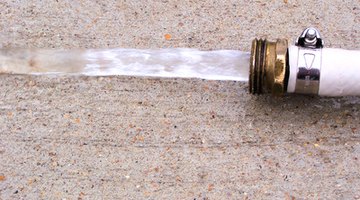How to Create a Vacuum with Running Water
Vacuuming has many applications including cleaning and draining or moving liquids. Vacuums use suction to move materials from one location to another. Vacuuming using running water, or siphoning, allows bodies of water to be cleaned or drained using a common garden hose.

This type of vacuuming relies on gravity to start and maintain the vacuum's suction. The body of water being vacuumed must be higher than the draining point for water to flow and create the vacuum effect.
Things You Will Need
- Garden hose
- Plugs
Tip
You can create a stronger vacuum by placing the draining end of the garden hose even lower than the vacuum end.
-
Attach one end of a garden hose to a water faucet. Plug the other end of the garden hose.
-
Turn on the water faucet to begin filling the garden hose with water. This process primes the hose, readying it for suction. Turn the faucet off once the hose is full of water.
-
Unscrew the hose from the faucet and insert a plug into the hose end to prevent water loss. Set one end of the hose down into the body of water you want to vacuum. Place the other end of the hose onto an open area lower than the body of water being vacuumed.
-
Unplug the garden hose end down in the body of water. Unplug the other hose end. Due to gravity, water begins flowing through the hose, creating a vacuum. Maneuver the hose end in the body of water to direct the vacuum.
The Drip Cap
- Vacuuming has many applications including cleaning and draining or moving liquids.
- This type of vacuuming relies on gravity to start and maintain the vacuum's suction.
- Turn on the water faucet to begin filling the garden hose with water.
- Set one end of the hose down into the body of water you want to vacuum.
References
Writer Bio
Justin A. Mann has been a freelance writer since 2007. Mann is experienced with computers and all things relating to swimming pools, and he uses his knowledge in these fields to write articles for various websites. Mann is an English major at East Central University.
Photo Credits
- water or garden hose image by Katrina Miller from Fotolia.com
- water or garden hose image by Katrina Miller from Fotolia.com
More Articles



